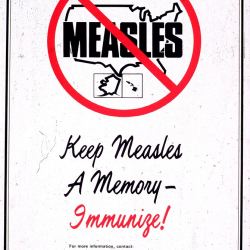This ancient warning resonates today as measles, a highly contagious and once nearly eradicated viral illness, experiences a resurgence. Fueled by misinformation and vaccine hesitancy, recent years have seen a troubling increase in cases, threatening the progress of public health efforts.
In 910, the Persian physician Al-Razi wrote that measles should be more dreaded than smallpox, an edict echoed in an old proverb:
“Count your children after the measles has passed.”
More than a thousand years later, measles remains the most contagious of modern diseases. In the first 75 days of this year, the number of US measles cases surpassed the entire tally for 2023. During the week from March 8 to 14 alone, fifteen new ones were reported, and as of the Ides of March 2024, 60 cases of measles had been reported in the US. Fortunately, it is also highly amenable to vaccination, and before the 2018-2019 measles pandemic, it had been virtually eliminated in most OECD countries. So, what happened? And should we care?
In 2000, the WHO declared measles officially eradicated from the US (with only a handful of cases, if any, reported yearly). In 2011, the trend slowly began to reverse, not coincidentally with the surge of the anti-vax “industry.” By 2018, the US nearly lost its official measles-free designation when a massive epidemic struck the country and remained out of control for exactly one year as unvaccinated travelers imported the disease and spread it in communities with low vaccination rates. Under-vaccinated communities in the New York counties of Kings and Rockland were hot spots of the disease, having been targeted by the irresponsible anti-vax “Informed Consent Action Network” (ICAN) and anti-vax individuals who blanketed the local population with leaflets and symposia, playing on local fears and superstitions.
A similar anti-vax campaign had been directed earlier against the Somali community in Minnesota, propagandizing a repeatedly debunked autism-MMR (measles, mumps, rubella) vaccine connection. Unsurprisingly, not long afterward, in 2011, the area experienced nearly twice as many cases as the total number during the prior decade. And in 2017, Minnesota had 75 cases -- again attributed to anti-vax-induced fear of vaccination. At the time, that was a national anomaly. Some still claim it isn’t a big deal.
The Anti-Vax Message
According to the Center for Countering Digital Hate, the generic anti-vax message is distilled into three components of false claims about measles (and also COVID):
- the disease is not dangerous, but
- the vaccine is, and
- the government and/or big pharma have been consistently untrustworthy
The facts argue otherwise:
Measles …is still responsible for more than 100,000 deaths worldwide every year, down from more than 2 million deaths annually before the introduction and widespread use of measles vaccine. – The Lancet
While the current flurry of US cases is still not particularly widespread, it was enabled by the vaccination rate dropping from 95% to 92%, reflecting how infectious and opportunistic the virus is. (There has been a bump in measles cases in Europe, too – a 30-fold increase in cases in 2023 compared to 2022.)
The recent history of measles infections is often, and inexplicably, ignored, even though its lessons are crucial to preventing a new onslaught. In 2019, the US experienced 1,274 measles cases, which were introduced by two unvaccinated international travelers. Of those infected, 75-80% were seeded by two New York outbreaks in population pockets with comparatively low vaccination rates. Some 5-10% of the cases required hospitalization, but according to the CDC, no Americans died. In Israel, however, where pre-school vaccination is not mandatory, there were more than 4,300 cases and three deaths.
Like COVID, measles has its own “long version.” Although the most often reported serious sequelae of measles are pneumonia and encephalitis, the phenomenon of “long measles” is devastating and has several manifestations:
“About one child in 1,000 who gets measles will develop encephalitis that can lead to convulsions and leave the child deaf or with intellectual disability. In rare cases, a delayed but fatal form of encephalitis develops seven to ten years later may …suppress… the immune system for up to two years, often called ‘the shadow of measles’ Recent studies determined that roughly 16% of children suffering measles acquire a severe case of this “immune amnesia,” where measles stripped away the immune protections these children had built to diseases and germs over years of exposure. Those children lost at least some immunity to more than 40% of common childhood diseases.”
There is also the constant threat of subacute sclerosing panencephalitis (SSPE), an inflammation of the brain resulting from an “inappropriate” immune response to the measles virus, which is progressively debilitating. SSPE usually develops between 2 and 10 years after the original viral infection. Initial symptoms may include memory loss, irritability, seizures, involuntary muscle movements, and/or behavioral changes, leading to neurological deterioration.
Measles Vaccination, A Victim of Its Success
Many classic novels contain a reference to a character suffering or dying from measles. This isn’t surprising since the disease was ubiquitous at many points in history. We owe the absence of cases and our relative nonchalance to widespread vaccination, which peaked after the two-shot vaccination regimen was implemented following the 1989-92 epidemic, using the improved vaccine perfected in 1968 by Dr. Maurice Hilleman.
Since then, measles vaccination has been, in effect, a victim of its success. Too many people have forgotten relatively recent history:
“The 1989-1992 US epidemic produced 57,859 cases, with more than 100 deaths. … At the middle of the 20th century – before anyone was vaccinated, measles killed some 400-500 a year, hospitalized another 48,000, and sickened a reported 500,000 including causing 4,000 cases of encephalitis. And these represent a gross improvement compared to the turn of the century, when an average of 5,300-6,000 succumbed to measles-related deaths, yearly.”
– The Panic Virus
However, it looks as though American society is regressing concerning infectious disease prevention. COVID is another case in point. Although cases are down drastically from the recent surges, COVID still accounts for about 2% of US deaths -- hundreds per week. Moreover, numerous COVID-19-infected Americans are at risk for long COVID, whose persistent signs and symptoms have eluded a cure or treatment. And yet, fewer than 20% of eligible Americans have been boosted with the most recent COVID vaccine.
Vaccine hesitancy has even infected dog owners, with veterinarians calling the condition "canine vaccine hesitancy." An article published last year in the journal Vaccine found that "a large minority of dog owners consider vaccines administered to dogs to be unsafe (37%), ineffective (22%), and/or unnecessary (30%)" and that a majority of dog owners (53%) hold one or more of those opinions, not unlike the human population.
“It’s really measles management 101. It’s not really supposed to be ‘choose your own adventure.’”
- Dr. Katelyn Jetelina, MPH, PhD in Epidemiology and Biostatistics
Perhaps worse than societal ambivalence or misadventure is the politicization of the message and the growth of anti-vax sentiment. Florida’s surgeon general and COVID-minimizer Joseph Ladapo, a political appointee of Governor Ron DeSantis, is promoting mass measles transmission by encouraging potentially infectious and unvaccinated children to attend school, thereby exposing their classmates. This policy, unsurprisingly, has been widely condemned by public health experts, given that the measles virus infects upwards of 90% of those who are unvaccinated. Even Ladapo’s predecessor, Florida's former Surgeon General Dr. Scott Rivkees, castigates Ladapo:
This is not a parental rights issue…It's about protecting fellow classmates, teachers, and members of the community against measles, which is a very serious and very transmissible illness.
Former President Trump, the likely Republican Presidential nominee, threatens to withdraw funds from any state with a vaccine or mask mandate. And while his campaign staff ad-libs that the rhetoric is confined to COVID (which is scant consolation), vaccine experts fear that anti-vaccine sentiment is, itself, a contagious disease that will infect and spread vaccine rejection for other diseases, as well.
"Trump “is an important voice. He has a big platform. And he uses that platform, in this case, to do harm. Because he’s implying by saying that we shouldn’t mandate vaccines, [that] vaccines are in some ways ineffective or unsafe."
- Paul Offit, MD, Pediatrician and Chairman, Therapeutic Standards Committee, The Children’s Hospital of Philadelphia
Indeed, following the COVID anti-vax propaganda barrage in 2020, childhood vaccination rates declined for the first time in a decade. They have not recovered. Having previously reached the 95% coverage rate ostensibly needed to achieve measles herd immunity, coverage today falls short, at around 92%. (Note that even the overall 95% rate was insufficient to prevent the 2018-2019 epidemic when, in some isolated areas, the vaccination rate ranged between 56-92%).)
The current upsurge in measles cases is not surprising, and we can expect to see more. This bodes worst for children for whom vaccines are contraindicated or ineffective because they are immunocompromised -- by illness or immunosuppressant drugs (e.g., secondary to autoimmune disease or organ transplantation -- and are dependent on vaccination of their schoolmates to avoid becoming infected.
The Freedom to Cause Harm
 Although all states have mandatory childhood vaccine requirements and permit exemptions for medical reasons, 45 states allow religious exemptions. (New York removed its religious exemption in 2019 in the wake of the measles crisis there). According to the CDC, the percentage of kindergartners whose parents opted them out of school-required vaccinations rose to the highest level during the 2022-2023 school year. Exemption rates rose in 41 states, the highest ever reported in the US. Ten states reported exemption rates over 5%, a prescription for the proliferation of preventable and potentially deadly diseases.
Although all states have mandatory childhood vaccine requirements and permit exemptions for medical reasons, 45 states allow religious exemptions. (New York removed its religious exemption in 2019 in the wake of the measles crisis there). According to the CDC, the percentage of kindergartners whose parents opted them out of school-required vaccinations rose to the highest level during the 2022-2023 school year. Exemption rates rose in 41 states, the highest ever reported in the US. Ten states reported exemption rates over 5%, a prescription for the proliferation of preventable and potentially deadly diseases.
Curiously, while the number of parents seeking religious exemptions has increased recently, the Pew Research Center documents a decrease in religiosity and an increase in people claiming no religious affiliation, i.e., – religious ‘nones’: 28% of Americans now consider themselves atheist, agnostic, or “nothing in particular.”
Not to fear, though, if you want to avoid vaccinating your kids: Fifteen states allow personal or philosophical exemptions, which provide a safe haven for those opposing vaccines based on no particular organized religious conviction. And some states, like Kansas and Montana, are floating the once unheard-of idea of loosening or removing mandatory vaccination entirely. This is certainly the epitome of freedom – the freedom to cause harm.
Our recommendation: If you want to be a responsible citizen, protect your children and your community’s health, vaccinate your kids, and keep them home if they have a fever, cough, runny nose, or pink eye (conjunctivitis).

